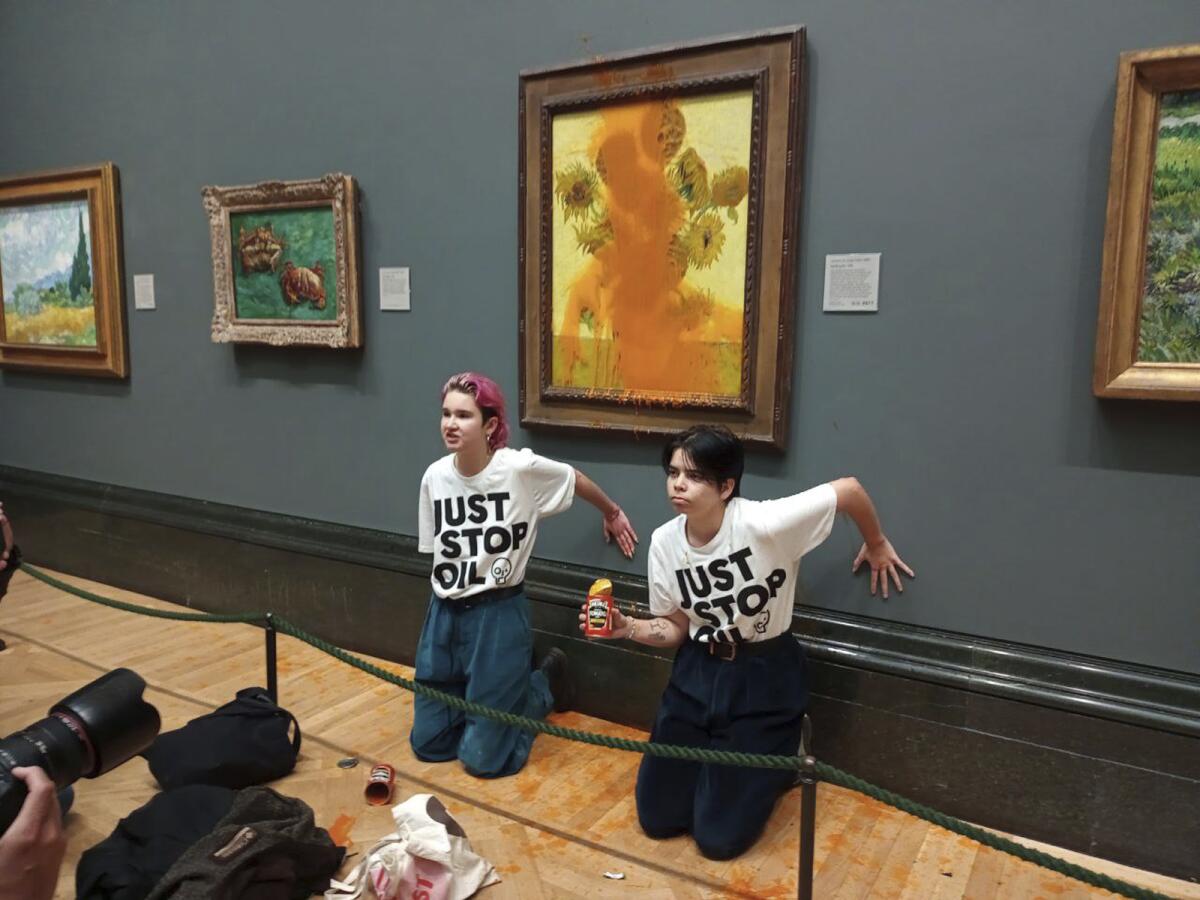‘Hot would be much worse’: How a priceless Van Gogh survived a tomato soup shower

- Share via
Talk about a food fight. The latest weapon of choice among climate activists? Tomato soup.
Protesters on Friday morning hurled two cans of tomato soup at Vincent van Gogh’s iconic 1888 “Sunflowers” painting in London’s National Gallery. The Just Stop Oil activists were making a statement against fossil fuel extraction, urging the British government to halt new oil and gas projects.
Two protesters, wearing “Just Stop Oil” T-shirts and still clutching the empty soup cans, appeared to glue themselves to the wall space beneath the painting. Directly above them, abstract smears of viscous soup dripped down the glass covering the masterpiece.
“What is worth more, art or life?” one activist yelled. “Is it worth more than food? More than justice?”
The oil-on-canvas artwork suffered no damage, but its frame did. The work was cleaned up and returned to its spot on the gallery wall the same day.
“If there hadn’t been glazing — glass on the front — it would have been serious but not disastrous,” says Chris Stavroudis, an independent, L.A.-based paintings conservator. “It’s water based, the soup, so [if on the canvas] it would have been removed quickly.”
The menu matters when it comes to food-on-art vandalism, Stavroudis says. Cream of mushroom soup? Probably not as much of a danger as the tomato.
“Tomato soup is acidic, so that’s a concern,” he says.
Stavroudis was not at the London gallery to observe the extent of the frame’s damage or how the museum responded to the incident. But as a paintings conservator, he’s developed unique cleaning systems for works of art, which he teaches internationally, and he has a pretty good idea of what might have occurred Friday morning, he says.
The wrath of the webbing clothes moth. During the yearlong COVID-19 closure, the Getty devoted more than 6,000 hours to eradicating this one insect.
The protesters, Stavroudis says, appear to have been mindful of not permanently damaging the painting. For one, they chose a work covered in glass — not all works are framed — and the soup appears to be condensed, he says, making it “less liquid-y” so there’s less drip. It was also unheated, which is less dangerous to the canvas.
“Hot would be much worse — the heat would allow the soup to penetrate faster and potentially weaken the canvas,” Stavroudis says. “If it were really hot it would cause the canvas to shrink locally and cause the paint to bubble up somewhat. Hot could seep in faster and disrupt the ground layer, the layer the paint is attached to.”
Most museums have an emergency kit for attacks on artworks, he says. Kits may contain materials to neutralize substances such as acid, for example. When a painting is attacked with liquid, it’s immediately laid flat, to prevent vertical dribbling and further spreading of the wet substance. Not much else is done until the museum’s conservator arrives on the scene.
The National Gallery said, in an email to The Times, that Room 43, where the Van Gogh painting was hanging, was immediately cleared of visitors and police quickly arrived on the scene.
The Van Gogh “Sunflowers” frame is probably made of wood under its gold and protective coatings, Stavroudis says. So it has a very water soluble layer of bole (glue and clay) or gesso (glue and chalk or plaster of paris) under the thin gilding. If the tomato soup seeped in far enough, it could cause the gold layer to release from the surface underneath.
“They wouldn’t replace the frame,” Stavroudis says. “They’d remove the soup with swabs and some of the gilding [might] come up when they cleaned the soup off. They may have to do some retouching to fill in the damage but it would just be a localized treatment where the soup was.”
The tomato soup incident was not an ode to Pop art — the brand of soup, as it turns out, was Heinz, not Campbell’s, the latter of which Andy Warhol so famously immortalized in his art.
Two protesters, the National Gallery said, were arrested on Friday, leaving their bellowed message fresh in the ears of bystanders.
“The cost of living crisis is part of the cost of oil crisis,” one protester had yelled out while standing in front of the painting. “Fuel is unaffordable to millions of cold, hungry families. They can’t even afford to heat a tin of soup.”
More to Read
The biggest entertainment stories
Get our big stories about Hollywood, film, television, music, arts, culture and more right in your inbox as soon as they publish.
You may occasionally receive promotional content from the Los Angeles Times.











